Lathe Machine
Lathe
a machine used mainly for working bodies of revolution by chip removal during turning. One of the most ancient machine tools, the lathe has served as the basis for drilling and boring machines.
Lathes make up an important, highly varied group of metalcutting machine tools. Among the turning operations that may be performed on lathes are the machining of cylindrical, conical, and irregularly shaped surfaces, the facing of ends, sectioning, and boring, as well as the drilling and reaming of holes, threading, knurling, and lapping. Milling, polishing, gear-cutting, and other operations may be performed on lathes using special jigs. Wheel pairs, couplings, and pipes are turned on specialized lathes.
The main components of a lathe are (1) the base, with a trough for the collection of the cutting fluid and chips; (2) the bed, with guides for the carriage and tailstock; (3) the fixed headstock, with a spindle and gearbox, which may be located elsewhere—for example, in the base; (4) the movable tailstock, which is attached to the bed in a specific position; (5) the feedbox, which is connected by clutches to the driveshaft and feed screw; (6) the apron, with mechanisms for transmitting motion from the driveshaft to the rack (or to the feed screw of the cross slides) and for coupling the split nut with the lead screw; (7) a support, consisting of a carriage moving along the bed guides, and cross slides moving along the carriage guides; and (8) the rotating unit, with guides for the upper carriage, on which the tool holder is mounted. The upper carriage also moves automatically in some models. The apron mechanism provides for blocking, which eliminates the simultaneous activation of the feed by the driveshaft and lead screw and simultaneous activation of the carriage and cross slides. For rapid traverse of the carriage, the driveshaft is powered by an auxiliary electric motor operating through an overrunning clutch.
During cutting on a lathe, the workpiece, which is held in a chuck or in conical pins, is rotated by the main drive. Provision is made for stepped or infinitely variable control of the speed of the spindle in order to attain the required rate of cutting. The translator motion of the cutting tool is produced by the kinematic chain of the feed motion, whose first unit is the spindle and whose last unit is a rack-and-gear drive in the case of turning or the kinematic pair of the feed screw and split nut in the case of threading. In the case of turning, the feed is adjusted by means of the feed-box; in the case of threading, an apparatus with replaceable gears in the feed adjustment unit, or bracket, is used.
The spindle unit is made rigid and resistant to vibration. The spindle usually rests on rolling-contact bearings. Hydrostatic bearings are used in precision lathes. A faceplate, on which the workpieces are mounted, may be attached to the front end of the spindle. The tailstock is used for working items in conical pins, as well as for fastening the tool in drilling, countersink reaming, and reaming.
The main drive of a lathe may include a single-speed or multi-speed asynchronous electric motor and a multistep gearbox or mechanical variable-speed drive. Regulated DC motors and gearboxes are usually used in heavy lathes. Other drives, such as hydraulic drives, are sometimes used.
The requirements for the automation of small-lot production have led to the development of numerically controlled lathes. These lathes have several special features. In addition to the traditional configuration, an arrangement is used in which the bed has inclined guides; this facilitates the removal of chips and protection of the work area. The cutting zone is covered by a hood. Among the operations that are programmed are range shifting, lengthwise and transverse movement of the carriage, with infinitely variable control of the feed, rapid traverse of the carriage, rotation of the turret, starting, stopping, and reversing of the main drive, and automatic tool changing (with a multitool mount). Self-centering chucks and automatic tailstocks are used in some center-type engine lathes. In many cases, lathes have rotating turrets with separate electric or hydraulic drive. The feed may be accomplished by means of stepped electric motors with servo control units, DC motors, and hydraulic motors; rolling (ball) feed screws are used. The tools are adjusted off the lathe, using optical devices or devices for adjusting cutters according to indicators or setting gauges. Only the replacement and attachment of previously adjusted units or of the entire tool holder are carried out on the lathe.
Universal lathes are used for unit and small-lot production. Lathes equipped with hydraulic and electric reproducing attachments and rapid-clamping automatic chucks may be used in lot production. Automatic and semiautomatic turning and turret systems are used in mass production. The servicing of such automatic systems is reduced to periodic adjustment, feed, and monitoring of the workpiece.
In semiautomatic systems, motions related to the loading and removal of the workpieces are not automated. Automatic control of the operating cycle of these machines is accomplished by means of a distributing shaft to which cams are attached. Three groups of automatic and semiautomatic lathe systems are distinguished on the basis of their auxiliary (return) movements. The first group includes machines with one distributing shaft that turns at a constant speed for a given setting; the shaft controls both the working and return movements. This scheme is used in small automatic systems with only a few return motions. The second group consists of machines with one distributing shaft having two speeds of rotation; the low speed is for the working movement, and the high speed is for return operations. This scheme is usually used for multispindle automatic and semiautomatic systems. The third group consists of machines that have, in addition to a distributing shaft, a high-speed auxiliary shaft, which carries out the return movements.
(For information on woodworking lathes, seeWOODWORKING MACHINE. See alsoVERTICAL LATHE and TURRET LATHE.)
REFERENCE
Metallorezhushchiestanki, 2nd ed., vol. 1. Moscow, 1965.G. A. LEVIT


